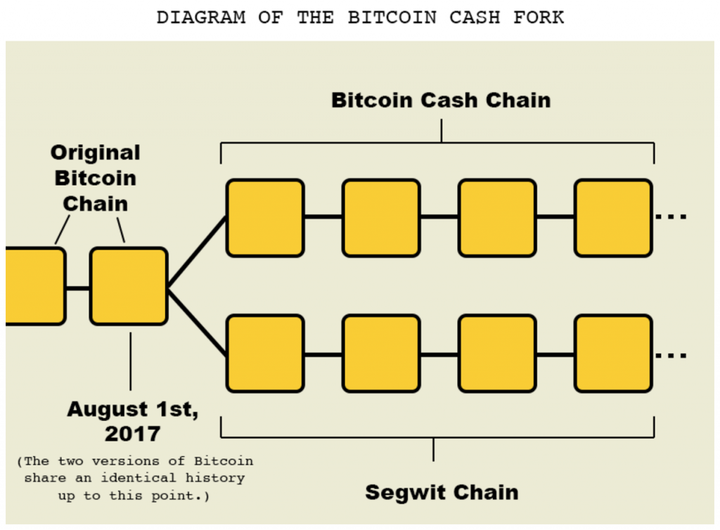
With Christmas and other winter celebrations wrapping up 2017, merchants are seeing the best holiday shopping season in years. In particular, holiday e-commerce spending is surging, estimated to break through $100 billion in 2017 in the United States alone, representing a 14% increase from last year. As more consumer buying is done online, merchants naturally want fast, reliable, low-fee payment systems. Today, e-commerce relies heavily on card payment systems like VISA and Mastercard. But as virtual currency becomes the future of money, what merchants want should be a cryptocurrency that offers bigger blocks for more transactions, faster speed, and lower transaction fees. What merchants really want for Christmas – and every day of the year – should be Bitcoin Cash.
The Bitcoin Scaling Debate
2017 was a breakout year for Bitcoin, the decentralized cryptocurrency which has soared in price over the past twelve months. But while the “legacy” Bitcoin (traded under the ticker symbol BTC) captured much media attention this year, a newer kid on the blockchain - Bitcoin Cash (ticker symbol BCH) - emerged in August 2017 via a “hard fork” of the original chain. Since then, it has quietly gained traction and I predict 2018 will be the year of Bitcoin Cash.
What’s the difference between these two coins and why should merchants care? Bitcoin was born through a 2008 white paper published under the pseudonym Satoshi Nakamoto. The paper’s title neatly summarizes the vision: Bitcoin: A Peer-to-Peer Electronic Cash System. Bitcoin was designed to be used as daily “electronic cash” by people worldwide. Its transformative concept was giving you the ability to send money or make payments directly to anyone in the world, without intermediary banks, payment processors or other trusted third parties in the middle. The transactions are recorded on a distributed ledger known as the blockchain, which is maintained by decentralized mining nodes rather than by a central authority. To achieve this vision, transactions on the Bitcoin blockchain need to be fast, low-fee, and instantly confirmed.
But due to internal debates within the Bitcoin community, the “legacy” Bitcoin (BTC) chain moved away from that direction. Its blocks remain capped at only 1MB in size. A new block is added to the blockchain every 10 minutes; with a 1MB data limit every 10 minutes, the legacy chain can process on average approximately 3 transactions per second (and at its maximum, 7 transactions per second). By comparison, the global VISA network averages 2,000 transactions per second, and can reach 56,000 transactions per second during peak periods (such as holiday shopping juggernauts Black Friday and Cyber Monday).
To increase the legacy Bitcoin network’s throughput capacity, an easy solution would be to just increase the block size. There have been efforts to raise the block size to 2MB, but that modest increase hardly solves the problem. Other proposed solutions are controversial – such as a technical change called “Segregated Witness” or SegWit, which refers to splitting signature data from the transaction data to save space. (In fact, once SegWit was actually activated in August 2017, the legacy Bitcoin is more appropriately called the “SegWit” chain and some cryptocurrency media sites – such as Bitcoin.com and CoinGeek.com have begun to call it by that name.)
At the core of this debate is a philosophical divide on what the Bitcoin network should be. Should the Bitcoin blockchain be just a “settlement layer” – relying on “off chain” or “side chain” solutions to do the fast payment processing on different layers, and periodically settle payment transactions to the blockchain? Or should it fulfill Satoshi Nakamoto’s vision of Bitcoin as a single “electronic cash” system where all transactions are processed and which is used by people efficiently around the world? The Bitcoin community thus split into two camps: “small blockers” and “big blockers.” While their disagreements continued, the legacy network did not scale bigger and faster; it slowed down with backlogs of unconfirmed transactions which could take hours to confirm and cost high fees to process. What consumer would use Bitcoin to pay for a $5.00 Starbucks coffee if it cost $10.00 or even as high as $28.00 just to process the transaction? And why would merchants want to use such a slow and costly payment system?
The Rise of Bitcoin Cash
Weary of waiting for the legacy Bitcoin chain to scale bigger and faster, on August 1, 2017, proponents of big blocks and the original Satoshi vision forked off onto a new chain called Bitcoin Cash (BCH). Its name emphasizes the goal of Bitcoin acting as electronic cash which is used, sent and spent on a daily basis – a future both consumers and merchants should welcome.

To achieve that vision, Bitcoin Cash (BCH) embraces bigger blocks. Its chain began with an initial default block size of 8MB - far larger than the SegWit Bitcoin (BTC) chain’s current 1MB or 2MB size; that allows an average 24 transactions per second. That of course is not enough to rival VISA or Mastercard speed. So the Bitcoin Cash (BCH) network plans to scale to much bigger blocks and ultimately millions of transactions per second. Its developer groups have already announced their goal to increase block size up to 32MB and higher in the future.
Through a joint Gigablock Testnet Initiative by Bitcoin Unlimited and our company nChain, blocks of up to 1 gigabyte in size (1000 megabytes!) have been successfully tested. That would enable throughout capacity of over 10,000 transactions per second, and 864 million transactions per day.
And if 1GB was not enough, 1 terabyte (1 million megabytes!) blocks could be viable. Joannes Vermorel, founder of Lokad (a quantitative supply chain technology provider in France), recently published “Terabyte Blocks for Bitcoin Cash” explaining how 1 TB blocks are viable on the Bitcoin Cash (BCH) chain. A single terabyte block (added every 10 minutes) can contain about 4 billion Bitcoin transactions, and provide capacity of 7 million transactions per second. Vermorel writes: “Assuming a worldwide population of 10 billion humans, terabyte blocks offer about 50 transactions per human per day (57 actually, but the extra numerical precision is not significant”)” and “50 transactions per day per human appears sufficient to cover all human-driven activities.” The scale of such a network is mind-boggling; it would enable Bitcoin Cash (BCH) to power not just monetary transactions but machine-to-machine data transactions of many types. Such a powerful network can power smart contracts, the Internet of Things, and even artificial intelligence. And as Vermorel explains, this is only possible on the Bitcoin Cash (BCH) network – not the Segwit Bitcoin (BTC) chain with its tiny 1MB blocks.
While the dream of a 1TB block remains in the future, there is no doubt that Bitcoin Cash (BCH) is headed to far bigger blocks. Its network will have faster speed, so that transactions confirm almost instantly rather than waiting in a backlog queue for hours. This yields low transaction fees, costing just cents per transaction. Moreover, the multiple developer groups for Bitcoin Cash (BCH) are coordinating on numerous other features for future protocol upgrades. This will ensure orderly growth of the network to become a global peer-to-peer electronic cash system.

Why Merchants Should Want Bitcoin Cash
The growth of Bitcoin Cash (BCH) comes just at the right time. Not that long ago, merchant adoption of Bitcoin was on the rise. But a JP Morgan report in 2017 found that retailer acceptance of Bitcoin has recently been declining. No doubt that was due to rising fees on the legacy chain. Just in December 2017, online gaming distributor Steam dropped Segwit Bitcoin (BTC) as a payment method due to increased transaction fees going from what was once $.20 to as high as $20.
Let’s examine the financial impact on leading e-commerce retailer Amazon. On this past Black Friday’s shopping days over Thanksgiving weekend in the U.S., Amazon processed 12.78 million online transactions (on November 23 and 24, 2017). On those dates, SegWit Bitcoin (BTC) transaction fees averaged $6 but Bitcoin Cash (BCH) transaction fees averaged around only $.20. If Amazon accepted Segwit Bitcoin (BTC) for its 12.78 million transactions, fees would have totaled $76 million; but with Bitcoin Cash (BCH), transaction fees would only be $2.5 million. However, most Bitcoin wallets are not yet configured for the cheaper fee structure the Bitcoin Cash (BCH) chain offers; by default, they use the same cost amount – expressed in Satoshis (one hundred millionth of a Bitcoin – the smallest unit) per data byte - that would be necessary on the Segwit Bitcoin (BTC) chain to process a transaction. Once wallets are properly re-configured for the Bitcoin Cash (BCH) chain, transactions fee could be as low as $0.02 per transaction, which would reduce total transaction fees to only $250,000 for Amazon to do 12.78 million transactions on a Black Friday weekend!
Given this sharp discrepancy in fee impact to merchants, it’s no coincidence that Bitpay, the leading Bitcoin payment solutions provider for merchants, recently decided to accept Bitcoin Cash (BCH) payments. In making this announcement, Bitpay explained that Bitcoin Cash (BCH) “allows for payments with significantly faster network confirmations and significantly lower miner fee costs.”
In a Bitcoin Cash (BCH) world with a massively-scaled network, merchants will benefit tremendously:
- Merchants will pay far lower transaction fees than on today’s payment card systems.
- Foreign currency exchange rates and costs will be minimized.
- With instant payment confirmations on the blockchain, chargebacks will create significantly less financial exposure to merchants.
- Auto-renewing payments can be automated on the blockchain with smart contracts. (Our company even has a patent-pending invention about that).
Those are keys to move eCommerce to bCommerce (Bitcoin commerce).
That’s a future we at nChain Group – along with many others around the globe – build towards with our research, development, intellectual property, and investments. Indeed, there is much work to do before Bitcoin Cash (BCH) fulfills the Satoshi Nakamoto vision of a global peer-to-peer electronic cash system. We need a massively scaled blockchain, more user-friendly Bitcoin wallets, better merchant point-of-sale applications for accepting Bitcoin, improved security solutions, and reasonable regulatory frameworks. But when the building blocks come together, Bitcoin Cash (BCH) has the power to make the global money system far more efficient and change how the world operates. That is why merchants should want Bitcoin Cash (which, one day, I believe will be known just as Bitcoin) – for Christmas, and every other day of the year.
Jimmy Nguyen is CEO of the nChain Group - the global leader in research and development of blockchain technologies. The nChain Group includes four business units: 1) nChain Limited – a blockchain research and development business; 2) nChain Holdings Limited – an intellectual property holding and commercialization company; 3) nChain Reaction – a new investment entity; and 4) nCrypt – a Bitcoin wallet and exchange in Canada. (nCrypt is currently known as nTrust, but will be re-branding in early 2018 to reflect its move to focus on Bitcoin.) The group of companies has grown to a team of over 60 world-class scientific research, engineering and business professionals primarily based in London, United Kingdom and Vancouver, Canada.
